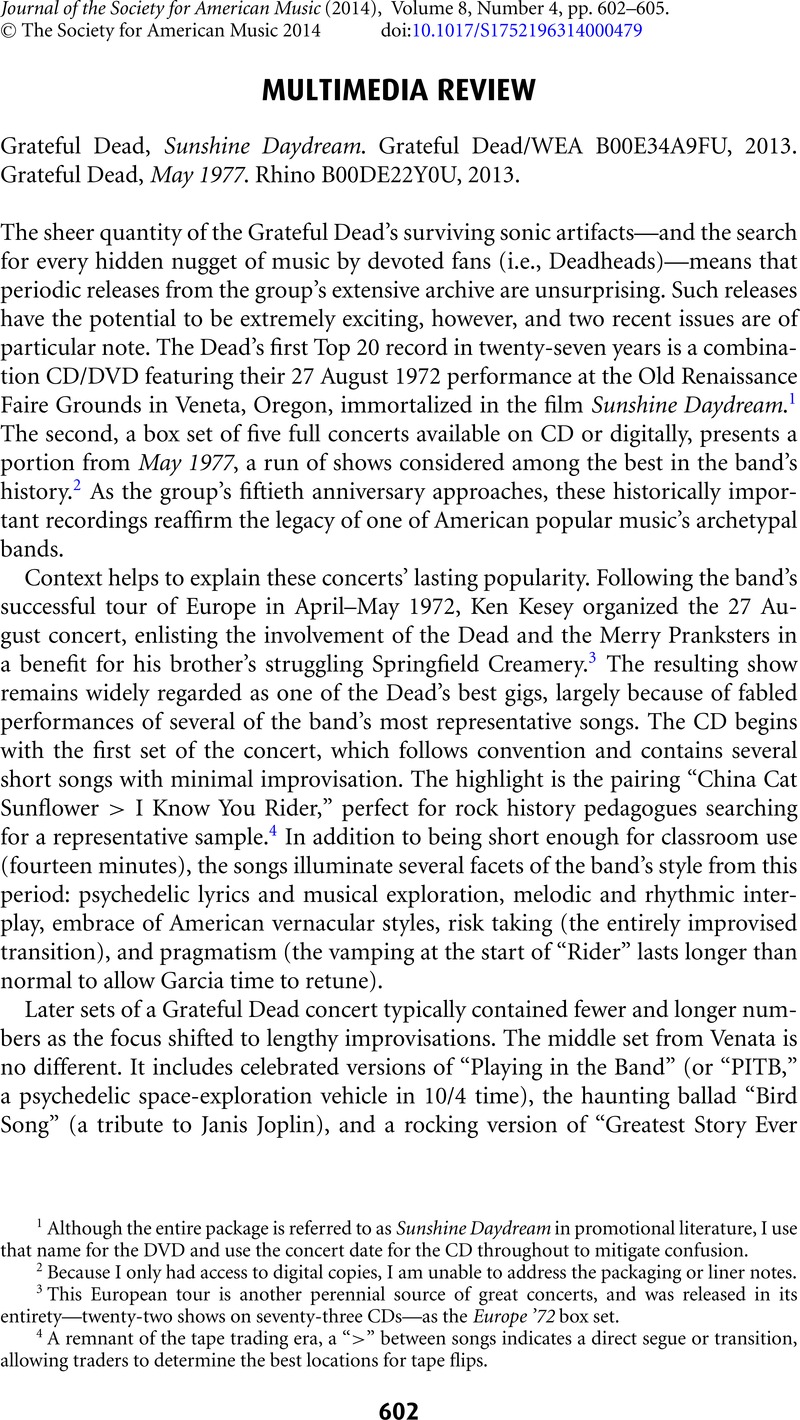No CrossRef data available.
Article contents
Grateful Dead, Sunshine Daydream. Grateful Dead/WEA B00E34A9FU, 2013./Grateful Dead, May 1977. Rhino B00DE22Y0U, 2013.
Published online by Cambridge University Press: 05 December 2014
Abstract

- Type
- Multimedia Review
- Information
- Copyright
- Copyright © The Society for American Music 2014
References
1 Although the entire package is referred to as Sunshine Daydream in promotional literature, I use that name for the DVD and use the concert date for the CD throughout to mitigate confusion.
2 Because I only had access to digital copies, I am unable to address the packaging or liner notes.
3 This European tour is another perennial source of great concerts, and was released in its entirety—twenty-two shows on seventy-three CDs—as the Europe ’72 box set.
4 A remnant of the tape trading era, a “>” between songs indicates a direct segue or transition, allowing traders to determine the best locations for tape flips.
5 For more on “PITB,” see Trudeau, Robert H., “A Super-Metacantric Analysis of ‘Playing in the Band’,” in Reading the Grateful Dead: A Critical Survey, ed. Meriwether, Nicholas G. (Lanham, MD: Scarecrow Press, 2012), 93–108Google Scholar.
6 For more on “Dark Star,” see Boone, Graeme M., “Dark Star Mandala,” in Reading the Grateful Dead: A Critical Survey, ed. Meriwether, Nicholas G. (Lanham, MD: Scarecrow Press, 2012), 85–106Google Scholar; and Boone, , “Tonal and Expressive Ambiguity in ‘Dark Star’,” in Understanding Rock: Essays in Musical Analysis, ed. Covach, John and Boone, Graeme M. (New York: Oxford University Press, 1997), 171–210Google Scholar. See also Richard Pettengill's consideration of this version in “Performing Collective Improvisation: The Grateful Dead's ‘Dark Star’,” in Taking it to the Bridge: Music as Performance, ed. Nicholas Cook and Richard Pettengill (Ann Arbor: University of Michigan Press, 2013), 37–51.
7 The hiss sounds worse out of the right channel, which is where both Lesh and Godchaux played if one were facing the stage. Godchaux is also less audible in my original bootlegs from the Europe 1972 tour than he is in the re-mastered box set versions, suggesting that he was lower in the original mixes during his first year on tour and that part of the hiss stems from boosting his levels to achieve parity with the rest of the band.
8 Blair Jackson, “Blair's Golden Road Blog—In the Shadow of the Moon: Terrapin Station at 35,” dead.net, http://www.dead.net/features/blair-jackson/blair-s-golden-road-blog-shadow-moon-terrapin-station-35?page=1.
9 This recording “has achieved almost mythic status among ‘Deadhead’ tape traders because of its excellent sound quality and early accessibility, as well as its musical performances.” See “The Full National Recording Registry,” Library of Congress, http://www.loc.gov/rr/record/nrpb/registry/nrpb-masterlist.html.
10 “Space” refers to a free, dissonant improvisation based on ideas that do not fit into other musical or conceptual categories (e.g., a “Dark Star” jam). For a metaphorical consideration of “Space,” see O’Donnell, Shaugn, “Space, Motion, and Other Musical Metaphors,” in Perspectives on the Grateful Dead: Critical Writings, ed. Weiner, Robert G. (Westport, CT: Greenwood Press, 1999), 127–36Google Scholar.
11 David Lemieux, “Seaside Chat: David Lemieux on 5/17/77,” http://www.youtube.com/watch?v=gL7H0tuASRU.
12 The existing “Scarlet Begonias” was mated with the new “Fire on the Mountain,” and “Estimated Prophet” was linked with the older “Eyes of the World.” Lemieux argues that the band had not yet fallen into the “format” that typifies second sets from ’78 on (a few songs, drum duet, “space,” a few more songs), and that these May 1977 sets were typically conceived of as “one continuous jam.” “Seaside Chat: David Lemieux on 5/12/77,” http://www.youtube.com/watch?v=EemMUs0Tm4M.




